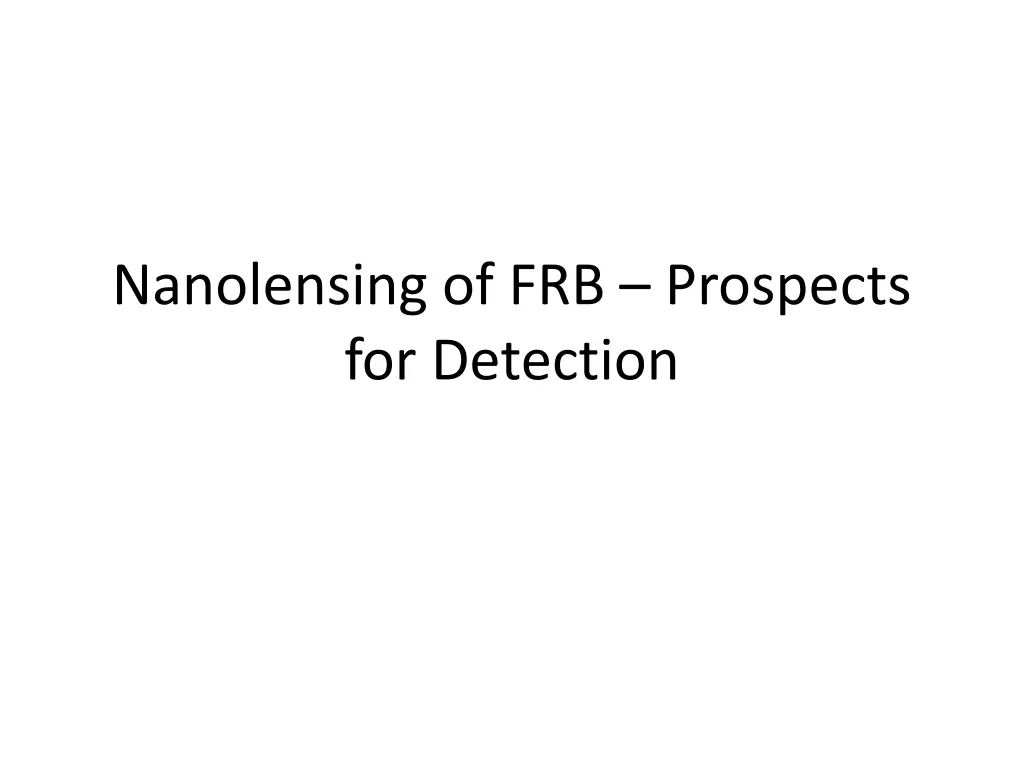
Nanolensing of Fast Radio Burst Detection
Discover the potential of nanolensing in detecting Fast Radio Bursts (FRBs) and the impact of gravitational lens delay on FRB observation rates. Learn how FFT radio arrays can store broadband signals and how gravitational lens delays can create correlations in FRB duration. Explore the effects of spread in delays and source motion on FRB detection, all explained through detailed images and analysis.
Download Presentation

Please find below an Image/Link to download the presentation.
The content on the website is provided AS IS for your information and personal use only. It may not be sold, licensed, or shared on other websites without obtaining consent from the author. If you encounter any issues during the download, it is possible that the publisher has removed the file from their server.
You are allowed to download the files provided on this website for personal or commercial use, subject to the condition that they are used lawfully. All files are the property of their respective owners.
The content on the website is provided AS IS for your information and personal use only. It may not be sold, licensed, or shared on other websites without obtaining consent from the author.
E N D
Presentation Transcript
Nanolensing of FRB Prospects for Detection
Gravitational Lens Delay between the two Images 2GM/c3=10-5 M/Msolars. 20 FRB/day amounts to over 7000/year! So there should be some lensing from known stellar and brown dwarf populations.
FFT radio arrays store E (t) For broadband signal such as FRB <E *(t) E(t )> goes to zero very rapidly when t -t is greater than >1/\nu The one exception: Gravitational lens delay >>1 ns can give large nonzero long term correlation <E*(t)E(t+ )>
The one exception: Gravitational lens delay >>1 ns can give large nonzero long term correlation <E*(t)E(t+ )> over the duration of the FRB <E*(t)E(t+ )>= \int [G*( )G( )]exp[i ] d Very huge, very narrow peaks at =
Such is the case if The spread in delays (e.g. due to finite source size ) is smaller than 1/ . The motion of the source does not change the delay by more than over the duration of the FRB. The absolute phase change due to the time difference is small.
Such is the case if The spread in delays (e.g. due to finite source size ) is smaller than 1/ . It is for source sizes < 1014 cm The motion of the source does not change the delay by more than over the duration of the FRB. It doesn t The absolute phase change due to the time difference is small. It s small.
The effective size of the source after scattering is less than the Einstein radius RE. Not a problem.
The phase change due to the different angles of the two images is small.
The phase change due to the different angles of the two images is small. Now let s think about this. The change in angle , ~RE/D ~ 10-11.5M/Msolar Whereas the decorrelation angle of the phase, judging from diffractive scintillation of pulsars, Is of order minutes (102 s) X pulsar velocity (~200 km/s) / distance to scattering screens = 2 X 109 cm/3 X 1020 cm ~ 10-11.5 ! So for (M~Msolar ), M<<Msolar, the condition (marginally) holds.
On the other hand, even marginal decorrelation due to diffractive scintillation should not destroy such a strong signal. To see this, consider what diffractive scintillation does to a delta function which is flat in space. It takes flat spectrum and wrinkles it into bunches typically peaking at ~ 1/tscin. For scattering screens in our galaxy, this is much less than 1/ . But even if it isn t, adding more Fourier components to power spectrum does not eliminate the one that already exists. There is an intervening Galaxy if there is a lens, but even apparent source motion of 104c does not move it over a phase decorrelation angle within the FRB duration. Host galaxy can do whatever it wants to the signal (as long as scattering size not ~ or > RE) So it seems that nanolensing is observable. Why not?
Detection of nanolensing could: limit MACHO to << baryon Determine mass function of brown dwarfs If NOT observed for some mass range, could tell us about the intervening plasma.

